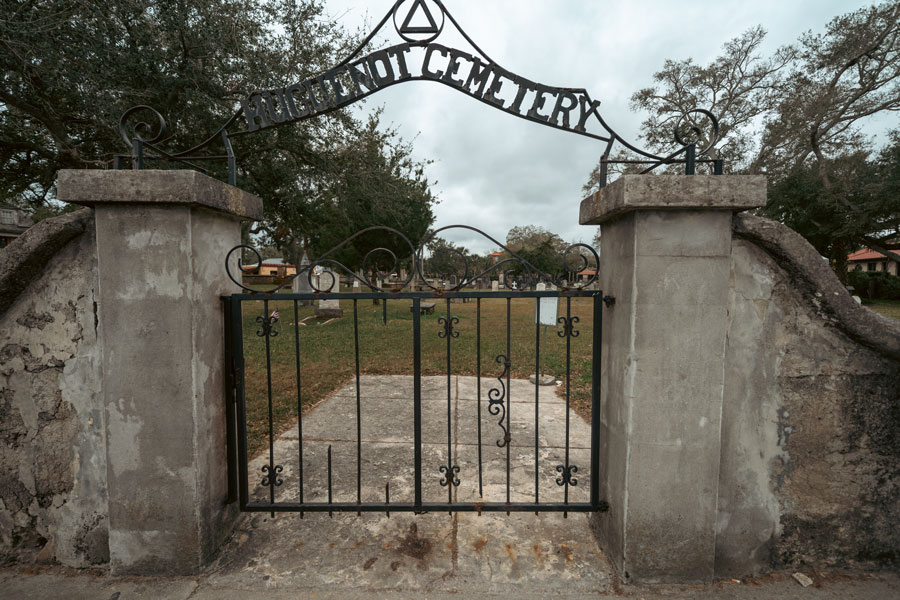St. Augustine’s “Spirit Central”

Tucked just outside St. Augustine’s 1808 City Gates, the Huguenot Cemetery (formally the “St. Augustine Public Burying Ground”) served as the city’s first Protestant graveyard from 1821 to 1884. Created during a devastating yellow-fever epidemic, it became the final resting place for an estimated 436 souls – from paupers to U.S. congressmen. Today, locals call it “Spirit Central” thanks to decades of unexplained lights, cold spots, and apparitions seen through its iron gates.
Historical Snapshot
- 1821: Florida passes from Spain to the United States; Catholic Tolomato Cemetery will not accept non-Catholics, so officials set aside this plot “just outside” town for newcomers struck down by yellow fever.
- 1832–1884: The Presbyterian Church manages the grounds; burials eventually cease when new municipal cemeteries open.
- Today: Friends of the Huguenot Cemetery volunteer group maintains the site; it was added to the National Register of Historic Places in 2021.
Ghostly Residents & Legends
- Judge John B. Stickney – Exhumed in 1909 so his children could rebury him in Washington D.C. While workers rested, thieves pried out his gold teeth. A tall man in a black hat now paces the rows, “searching” for them. Day & night sightings; shadowy figure near the front gate.
- Elizabeth / the 14-Year-Old Girl – Unclaimed yellow-fever victim left at the City Gates and interred in a pauper’s grave. Visitors hear soft crying and glimpse a pale girl in a white gown who vanishes among the stones. Central section of the grounds after dusk.
- Unnamed Yellow-Fever Dead – Quick burials during the 1821 epidemic supposedly trapped restless spirits. Many report faint lantern-lights weaving through headstones on humid nights. Along rear wall facing the marsh.
With so many tales, it’s little wonder tour guides deem the cemetery “the most haunted spot in the Ancient City.”
Visiting Information
- Location – Corner of A-1-A/Orange St. & Cordova St., directly beside the City Gates.
- Public Access – Gates are normally locked to protect fragile monuments. However, the Friends of the Huguenot Cemetery open the grounds every third Saturday, 11 a.m.–2 p.m. Docents on site; admission free, donations welcome.
- Photography – Permitted from the sidewalk 365 days a year; interior photos allowed only during open-gate hours.
- Ghost & History Tours – The cemetery is a highlight on several night-time excursions: Ghosts & Gravestones Trolley – narrated ride that pauses at the gate for spine-tingling stories. Original Ghost Tours of St. Augustine – small-group walk covering Huguenot, Tolomato, and other North-Side haunts.
Vicinity of the Cemetery
Nearby Points of Interest
- St. Augustine City Gates – Spanish-era coquina arches, steps from the cemetery entrance.
- Castillo de San Marcos – 17th-century fort overlooking Matanzas Bay (½-mile).
- Old Jail Museum – another Flagler-era haunt featured on Ghosts & Gravestones tours (1 mile).
- St. George Street – pedestrian lane of shops & cafés linking many haunted stops.
Visitor Tips
- Plan for Limited Entry: If you want inside access, schedule your trip around the third-Saturday opening or book a specialty tour granted interior time.
- Respect the Resting Place: No gravestone rubbings, food, or loud EVP sessions; the site is delicate and protected.
- Evening Atmosphere: After dark, view the grounds from outside the fence—streetlamps and Spanish moss create an eerie backdrop for photos (and maybe ghost lights).
- Weather Watch: Summers are hot and buggy; carry water and repellent. Winter nights are cooler but prime time for “lantern-light” sightings reported by locals.
Why Visit?
The Huguenot Cemetery offers a rare blend of early-American history and enduring supernatural folklore. Stand where yellow-fever doctors toiled, peer through wrought-iron gates at centuries-old markers, and ponder whether Judge Stickney still prowls for his missing treasure. Whether you’re chronicling cemeteries, tracing genealogy, or chasing chills, this modest half-acre delivers an unforgettable glimpse into the seen and unseen heart of America’s oldest city.

